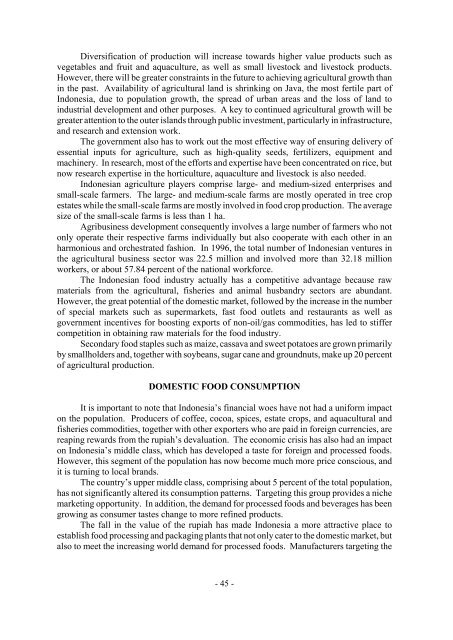Development of Agribusiness Enterprises - Asian Productivity ...
Development of Agribusiness Enterprises - Asian Productivity ...
Development of Agribusiness Enterprises - Asian Productivity ...
You also want an ePaper? Increase the reach of your titles
YUMPU automatically turns print PDFs into web optimized ePapers that Google loves.
Diversification <strong>of</strong> production will increase towards higher value products such as<br />
vegetables and fruit and aquaculture, as well as small livestock and livestock products.<br />
However, there will be greater constraints in the future to achieving agricultural growth than<br />
in the past. Availability <strong>of</strong> agricultural land is shrinking on Java, the most fertile part <strong>of</strong><br />
Indonesia, due to population growth, the spread <strong>of</strong> urban areas and the loss <strong>of</strong> land to<br />
industrial development and other purposes. A key to continued agricultural growth will be<br />
greater attention to the outer islands through public investment, particularly in infrastructure,<br />
and research and extension work.<br />
The government also has to work out the most effective way <strong>of</strong> ensuring delivery <strong>of</strong><br />
essential inputs for agriculture, such as high-quality seeds, fertilizers, equipment and<br />
machinery. In research, most <strong>of</strong> the efforts and expertise have been concentrated on rice, but<br />
now research expertise in the horticulture, aquaculture and livestock is also needed.<br />
Indonesian agriculture players comprise large- and medium-sized enterprises and<br />
small-scale farmers. The large- and medium-scale farms are mostly operated in tree crop<br />
estates while the small-scale farms are mostly involved in food crop production. The average<br />
size <strong>of</strong> the small-scale farms is less than 1 ha.<br />
<strong>Agribusiness</strong> development consequently involves a large number <strong>of</strong> farmers who not<br />
only operate their respective farms individually but also cooperate with each other in an<br />
harmonious and orchestrated fashion. In 1996, the total number <strong>of</strong> Indonesian ventures in<br />
the agricultural business sector was 22.5 million and involved more than 32.18 million<br />
workers, or about 57.84 percent <strong>of</strong> the national workforce.<br />
The Indonesian food industry actually has a competitive advantage because raw<br />
materials from the agricultural, fisheries and animal husbandry sectors are abundant.<br />
However, the great potential <strong>of</strong> the domestic market, followed by the increase in the number<br />
<strong>of</strong> special markets such as supermarkets, fast food outlets and restaurants as well as<br />
government incentives for boosting exports <strong>of</strong> non-oil/gas commodities, has led to stiffer<br />
competition in obtaining raw materials for the food industry.<br />
Secondary food staples such as maize, cassava and sweet potatoes are grown primarily<br />
by smallholders and, together with soybeans, sugar cane and groundnuts, make up 20 percent<br />
<strong>of</strong> agricultural production.<br />
DOMESTIC FOOD CONSUMPTION<br />
It is important to note that Indonesia’s financial woes have not had a uniform impact<br />
on the population. Producers <strong>of</strong> c<strong>of</strong>fee, cocoa, spices, estate crops, and aquacultural and<br />
fisheries commodities, together with other exporters who are paid in foreign currencies, are<br />
reaping rewards from the rupiah’s devaluation. The economic crisis has also had an impact<br />
on Indonesia’s middle class, which has developed a taste for foreign and processed foods.<br />
However, this segment <strong>of</strong> the population has now become much more price conscious, and<br />
it is turning to local brands.<br />
The country’s upper middle class, comprising about 5 percent <strong>of</strong> the total population,<br />
has not significantly altered its consumption patterns. Targeting this group provides a niche<br />
marketing opportunity. In addition, the demand for processed foods and beverages has been<br />
growing as consumer tastes change to more refined products.<br />
The fall in the value <strong>of</strong> the rupiah has made Indonesia a more attractive place to<br />
establish food processing and packaging plants that not only cater to the domestic market, but<br />
also to meet the increasing world demand for processed foods. Manufacturers targeting the<br />
- 45 -
















